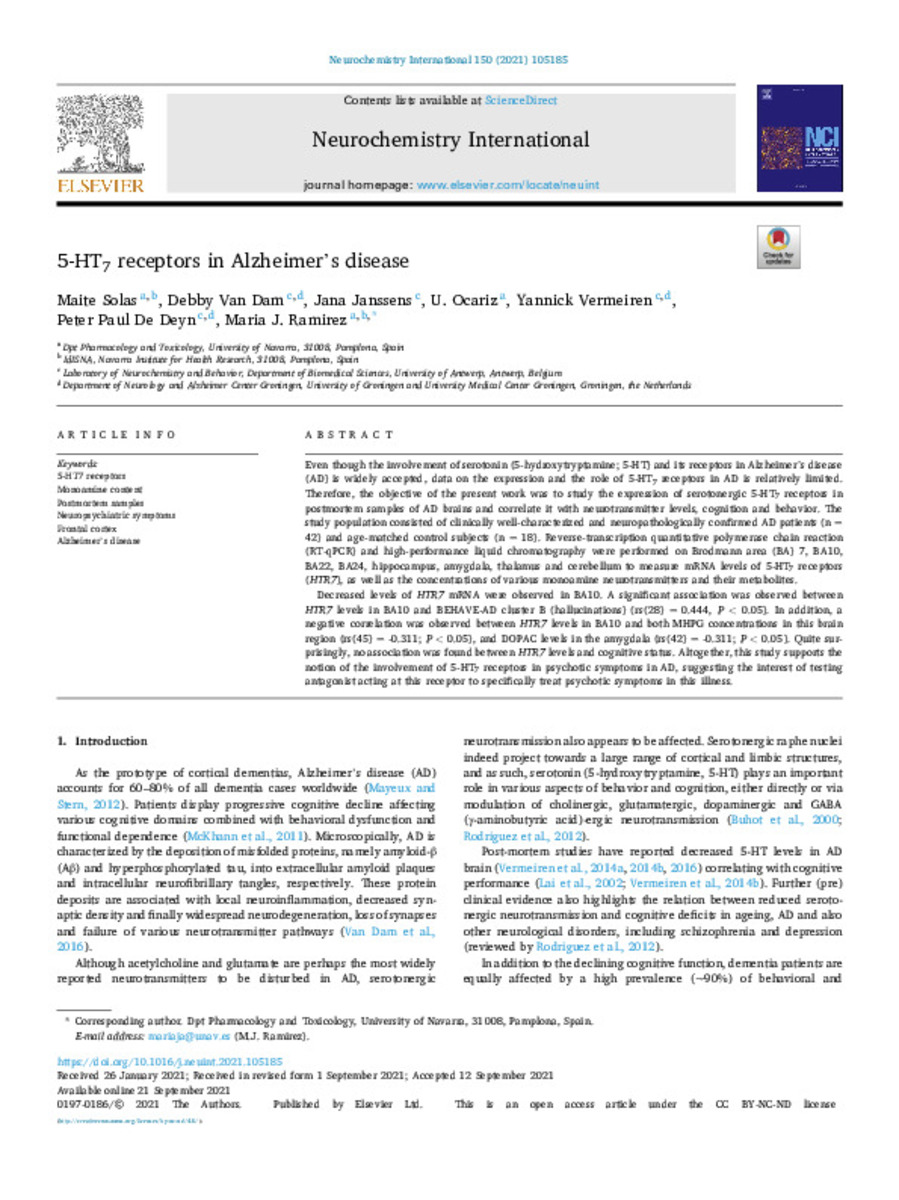Full metadata record
| DC Field | Value | Language |
|---|---|---|
| dc.creator | Solas, M. (Maite) | - |
| dc.creator | Van-Dam, D. (Debby) | - |
| dc.creator | Janssens, J. (Jana) | - |
| dc.creator | Ocariz-Díez, U. (Urtzi) | - |
| dc.creator | Vermeiren, Y. (Yannick) | - |
| dc.creator | De-Deyn, P.P. (Peter Paul) | - |
| dc.creator | Ramirez, M.J. (María Javier) | - |
| dc.date.accessioned | 2022-04-13T08:54:59Z | - |
| dc.date.available | 2022-04-13T08:54:59Z | - |
| dc.date.issued | 2021 | - |
| dc.identifier.citation | Solas, M. (Maite); Van-Dam, D. (Debby); Janssens, J. (Jana); et al. "5-HT7 receptors in Alzheimer's disease". Neurochemistry International. (150), 2021, 105185 | es_ES |
| dc.identifier.issn | 0197-0186 | - |
| dc.identifier.uri | https://hdl.handle.net/10171/63383 | - |
| dc.description.abstract | Even though the involvement of serotonin (5-hydroxytryptamine; 5-HT) and its receptors in Alzheimer’s disease (AD) is widely accepted, data on the expression and the role of 5-HT7 receptors in AD is relatively limited. Therefore, the objective of the present work was to study the expression of serotonergic 5-HT7 receptors in postmortem samples of AD brains and correlate it with neurotransmitter levels, cognition and behavior. The study population consisted of clinically well-characterized and neuropathologically confirmed AD patients (n = 42) and age-matched control subjects (n = 18). Reverse-transcription quantitative polymerase chain reaction (RT-qPCR) and high-performance liquid chromatography were performed on Brodmann area (BA) 7, BA10, BA22, BA24, hippocampus, amygdala, thalamus and cerebellum to measure mRNA levels of 5-HT7 receptors (HTR7), as well as the concentrations of various monoamine neurotransmitters and their metabolites. Decreased levels of HTR7 mRNA were observed in BA10. A significant association was observed between HTR7 levels in BA10 and BEHAVE-AD cluster B (hallucinations) (rs(28) = 0.444, P < 0.05). In addition, a negative correlation was observed between HTR7 levels in BA10 and both MHPG concentrations in this brain region (rs(45) = -0.311; P < 0.05), and DOPAC levels in the amygdala (rs(42) = -0.311; P < 0.05). Quite sur- prisingly, no association was found between HTR7 levels and cognitive status. Altogether, this study supports the notion of the involvement of 5-HT7 receptors in psychotic symptoms in AD, suggesting the interest of testing antagonist acting at this receptor to specifically treat psychotic symptoms in this illness. | es_ES |
| dc.description.sponsorship | This research was funded by the Research Foundation-Flanders (FWO, grant G053218N), Belgian Alzheimer Research Foundation (SAO-FRA, grant 2017/0025, 2018/0027), Alzheimer Nederland (grant WE.03-2019-11), Alzheimer Center Groningen (UMCG), the Medical Research Foundation Antwerp, and Neurosearch Antwerp. | es_ES |
| dc.language.iso | eng | es_ES |
| dc.publisher | Elsevier | es_ES |
| dc.rights | info:eu-repo/semantics/openAccess | es_ES |
| dc.subject | 5-HT7 receptors | es_ES |
| dc.subject | Monoamine content | es_ES |
| dc.subject | Postmortem samples | es_ES |
| dc.subject | Neuropsychiatric symptoms | es_ES |
| dc.subject | Frontal cortex | es_ES |
| dc.subject | Alzheimer’s disease | es_ES |
| dc.title | 5-HT7 receptors in Alzheimer's disease | es_ES |
| dc.type | info:eu-repo/semantics/article | es_ES |
| dc.description.note | This is an open access article under the CC BY-NC-ND license | es_ES |
| dc.identifier.doi | 10.1016/j.neuint.2021.105185 | - |
| dadun.citation.number | 150 | es_ES |
| dadun.citation.publicationName | Neurochemistry International | es_ES |
| dadun.citation.startingPage | 105185 | es_ES |
Files in This Item:
Statistics and impact
Items in Dadun are protected by copyright, with all rights reserved, unless otherwise indicated.






